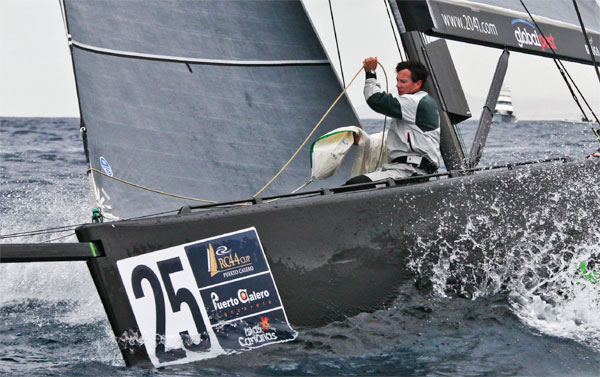
Cassidy
If you go by results, Matt Cassidy may have been the most successful big-boat sailor in the world last year, yet few know of his accomplishments. Cassidy is a bowman, and like all crew forward of the traveler, his name is rarely mentioned in results or press releases. In fact, we almost overlooked him as well even though he was on the winning teams of the RC44 class overall championship (Team Aqua), the Alpari World Match Racing Tour (Ian William’s GAC Pindar match racing team), the Audi MedCup, and the TP52 Worlds (Quantum Racing). It’s high time we learn more about this hard-working sailor.
Cassidy’s 15 tips on how to be a better bowman
Sailing World: Success on keelboats is a team effort. What did you bring to each of these programs?
Matt Cassidy: Since I’m doing bow or mid-bow on those programs, I try to make sure the crewwork is as flawless as possible. A lot of tacticians and helmsmen tend to micromanage. They are good at what they do, and they have a good view of what’s going on inside the boat. But micromanaging the rest of the crew takes away from their driving or calling tactics. If the guys in the back don’t have to worry about the mark roundings or the spinnaker drops, they can focus on their jobs.
That’s the goal of every bowman, but it’s easier said than done. How often can you turn around and say, “I got this!” without being a mouthy bowman?
Yelling on a boat never accomplishes anything. You have to be calm. The respect isn’t going to be there the first day. Once you sail with someone or a team a few times, they start to develop that respect. My theory is you just take control of the bow. If I try to anticipate what the tactician is doing, or if we’re coming into a gate at the bottom of the course and he’s not sure where to go, I take control of what’s happening up front. I work with the group of guys around me that are really focused on the boathandling. I talk to everyone and make sure we’re all on the same page. You have your game plan, your set plays, and the more you can do those without messing up, then the guys in the back will develop that confidence and let you do your job.
One thing professional sailors must learn is to mesh quickly with a new team. How do you get everyone on the same page and pulling in the same direction as quickly as possible?
Have a team meeting before you leave the dock and run over the basics. Talk amongst the team about the basic maneuvers, and then you just go out and do a couple laps, a couple hoists, a couple jibes and drops, and see what’s lacking. If things aren’t going well, take a break and talk about it. Then start over, and keep going until the crew work is polished.
What do you do when you find yourself in a situation where the tactician or skipper is asking for a maneuver that you think is too risky?
The afterguard is always going to want to push a situation. Most hairy situations occur at the bottom of the course. For example, they want to keep the kite up as long as possible. If it gets to the point where I’m uncomfortable that the maneuver will not get done in time, then I just override and take control of things up front. If that proves to be the wrong call, then we’ll talk about it later. Then you just refine it. Video is a great tool for this. If you think it takes 10 seconds to do something, but on the video it only takes 6 or 7 seconds, then next time you can push it a little bit further. Ultimately the responsibility of the sails going up and down properly falls on the bowman and the guys around him.
To make this work, you need to have a good working relationship with the pitman. He’s probably hearing it from both ends and if he doesn’t do what you expect, that’s a recipe for chaos.
Fortunately I sail on the boats where the pit guys are really good and they also know the timing. Good pit guys are tuned in to the guys up forward who are actually pulling in the sails.
Another area where bowmen are really exposed is the start; how do you call the start?
I love line sights and try to use them as much as possible. But sailing offshore, with bigger boats, often there are no sights and it makes it a little more difficult. That’s where the electronics come in. Actually doing the acceleration, however, and knowing the speed-build angles is a completely different thing. If the boat doesn’t accelerate at the proper time, then all the perfect timing in the world doesn’t help. We work on acceleration drills as much as possible to get the helmsman, the trimmers, and the bow in tune. If you do them enough, you will know how long it takes for a boat to accelerate and it makes the timing much easier.
Bow can be a pretty physical job, mid-bow can be a brutal job, especially if you have to go down below and pack sails. What physical training is important?
I go to the gym every day when I’m home and as much as possible when we’re on the road. A lot of the stuff I’m doing is core training because the balance up front is a big thing and a lot of balance comes from your core. I also try to do quick bursts of cardio. As the mid-bow on the TP52 you do a lot of grinding when working the runners.
Do you have any favorite exercises when you talk about core training?
I do a lot of weight training on the exercise ball. I use medicine balls going side-to-side, push-ups with kettlebells, kettlebell swings, and planks. If you can do a core exercise while on a Bosu Ball or balance board then it makes the exercise that much better.
How important is it for a bowman to do some trimming and to occasionally move back in the boat and experience other positions?
It’s super important. One of the things we try to do is switch roles, if you have an hour or two to just go screw around. Have, for example, the pit guy drive, or the bowman trim the main, etc., and try a few maneuvers. It might not be pretty, but you will experience what the other guys are going through.
What about mental attitude and your dedication to the bowman’s role within a team?
I want to do my job as well as I can, and I have to go out there with the mentality that I’m just as good as anyone out there. It’s just like with American football; you don’t see one guy playing a bunch of different positions. When you get to the higher levels, the pro-circuits, in sailing, everyone is so good that being a specialist in your position is what separates you from the pack. The cool thing about sailing is that it’s always changing. You’re never perfect and you’re always learning.
It doesn’t sound like you have any plans to migrate to the back of the boat any time soon.
No, I enjoy it. There hasn’t been one regatta I’ve done that I think was perfect, where we’ve had a perfect start every time, and flawless crew work every single race. If everyone wants to do their job as best as they can, then you will have a good team.









